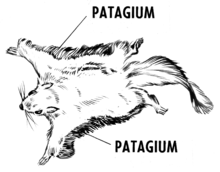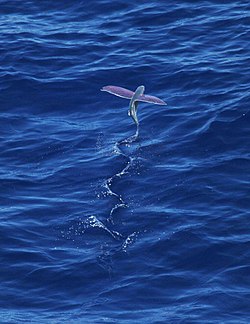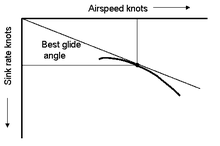Gliding flight
Gliding flight is heavier-than-air flight without the use of thrust; the term volplaning also refers to this mode of flight in animals.[1] It is employed by gliding animals and by aircraft such as gliders. This mode of flight involves flying a significant distance horizontally compared to its descent and therefore can be distinguished from a mostly straight downward descent like a round parachute.
Although the human application of gliding flight usually refers to aircraft designed for this purpose, most powered aircraft are capable of gliding without engine power. As with sustained flight, gliding generally requires the application of an
Aircraft ("gliders")
Most winged aircraft can glide to some extent, but there are several types of aircraft designed to glide:
- Glider, also known as a sailplane
- Hang glider
- Paraglider
- Speed glider
- Ram-air parachute
- Rotor kite, if untethered, known as a rotary glider, or gyroglider.
- Military glider
- Paper aeroplane
- Radio-controlled glider
- Rocket glider
- Wingsuit
The main human application is currently recreational, though during the Second World War
In addition to motor gliders, some powered aircraft are designed for routine glides during part of their flight; usually when landing after a period of a powered flight. These include:
- Experimental aircraft such as the North American X-15, which glided back having used their fuel
- Spacecraft such as the Space Shuttles, SpaceShipOne and the Russian Buran
Some aircraft are not designed to glide except in an emergency, such as engine failure or fuel exhaustion. See list of airline flights that required gliding flight. Gliding in a helicopter is called autorotation.
Gliding animals
Birds
A number of animals have separately evolved gliding many times, without any single ancestor. Birds in particular use gliding flight to minimise their use of energy. Large birds are notably adept at gliding, including:
Like recreational aircraft, birds can alternate periods of gliding with periods of soaring in rising air, and so spend a considerable time airborne with a minimal expenditure of energy. The great frigatebird in particular is capable of continuous flights up to several weeks.[3]
Mammals

To assist gliding, some mammals have evolved a structure called the patagium. This is a membranous structure found stretched between a range of body parts. It is most highly developed in bats. For similar reasons to birds, bats can glide efficiently. In bats, the skin forming the surface of the wing is an extension of the skin of the abdomen that runs to the tip of each digit, uniting the forelimb with the body. The patagium of a bat has four distinct parts:
- Propatagium: the patagium present from the neck to the first digit
- Dactylopatagium: the portion found within the digits
- Plagiopatagium: the portion found between the last digit and the hindlimbs
- Uropatagium: the posterior portion of the body between the two hindlimbs
Other mammals such as gliding possums and flying squirrels also glide using a patagium, but with much poorer efficiency than bats. They cannot gain height. The animal launches itself from a tree, spreading its limbs to expose the gliding membranes, usually to get from tree to tree in rainforests as an efficient means of both locating food and evading predators. This form of arboreal locomotion, is common in tropical regions such as Borneo and Australia, where the trees are tall and widely spaced.
In flying squirrels, the patagium stretches from the fore- to the hind-limbs along the length of each side of the torso. In the
Fish, reptiles, amphibians and other gliding animals
In addition to mammals and birds, other animals notably

The flights of flying fish are typically around 50 meters (160 ft),
Snakes of the genus
Flying lizards of the genus Draco are capable of gliding flight via membranes that may be extended to create wings (patagia), formed by an enlarged set of ribs.[17]
Gliding flight has evolved independently among 3,400 species of frogs[18] from both New World (Hylidae) and Old World (Rhacophoridae) families.[19] This parallel evolution is seen as an adaptation to their life in trees, high above the ground. Characteristics of the Old World species include "enlarged hands and feet, full webbing between all fingers and toes, lateral skin flaps on the arms and legs
Forces

Three principal forces act on aircraft and animals when gliding:[20]
- weight – gravity acts in the downwards direction
- lift – acts perpendicularly to the vector representing airspeed
- drag – acts parallel to the vector representing the airspeed
As the aircraft or animal descends, the air moving over the wings generates
Lift to drag ratio


The lift-to-drag ratio, or L/D ratio, is the amount of lift generated by a wing or vehicle, divided by the drag it creates by moving through the air. A higher or more favourable L/D ratio is typically one of the major goals in aircraft design; since a particular aircraft's needed lift is set by its weight, delivering that lift with lower drag leads directly to better fuel economy and climb performance.
The effect of
As lift and drag are both proportional to the coefficient of Lift and Drag respectively multiplied by the same factor (1/2 ρair v2S), the L/D ratio can be simplified to the Coefficient of lift divided by the coefficient of drag or Cl/Cd, and since both are proportional to the airspeed, the ratio of L/D or Cl/Cd is then typically plotted against angle of attack.
Drag
As lift increases steadily until the critical angle, it is normally the point where the combined drag is at its lowest, that the wing or aircraft is performing at its best L/D.
Designers will typically select a wing design which produces an L/D peak at the chosen
Minimising drag is of particular interest in the design and operation of high performance glider (sailplane)s, the largest of which can have glide ratios approaching 60 to 1, though many others have a lower performance; 25:1 being considered adequate for training use.
Glide ratio
When flown at a constant speed in still air a glider moves forwards a certain distance for a certain distance downwards. The ratio of the distance forwards to downwards is called the glide ratio. The glide ratio (E) is numerically equal to the lift-to-drag ratio under these conditions; but is not necessarily equal during other manoeuvres, especially if speed is not constant. A glider's glide ratio varies with airspeed, but there is a maximum value which is frequently quoted. Glide ratio usually varies little with vehicle loading; a heavier vehicle glides faster, but nearly maintains its glide ratio.[21]

Glide ratio (or "finesse") is the
Glide number (ε) is the reciprocal of glide ratio but sometime it is confused.
Examples
| Flight article | Scenario | glide ratio
|
|---|---|---|
| Eta (glider) | Gliding | 70[22] |
| Great frigatebird | Soaring over the ocean | 15–22 at typical speeds[23] |
Hang glider
|
Gliding | 15 |
| Air Canada Flight 143 (Gimli Glider) | fuel exhaustion
|
12~ |
British Airways Flight 9
|
Boeing 747-200B when all engines failed due to volcanic ash | 15~ |
| Paraglider | High performance model | 11 |
| Helicopter | in autorotation | 4 |
| Powered parachute | with a rectangular or elliptical parachute | 3.6/5.6 |
| Space Shuttle | unpowered approach from space after re-entry | 4.5[24] |
Wingsuit
|
while gliding | 3 |
| Hypersonic Technology Vehicle 2 | Equilibrium hypersonic gliding estimate[25] | 2.6 |
| Northern flying squirrel | Gliding | 1.98 |
| Sugar glider (possum) | Gliding | 1.82[26] |
| Space Shuttle | Supersonic | 2 (at Mach 2.5)[24] |
| Space Shuttle | Hypersonic | 1.8 (at Mach 5), 1 (over Mach 9)[24] |
Apollo CM
|
Transonic | 0.50 (at Mach 1.13)[27] |
Apollo CM
|
Reentry and hypersonic | 0.368 avg (prior to 1st peak g), 0.41 (at Mach 6)[27] |
Importance of the glide ratio in gliding flight

Although the best glide ratio is important when measuring the performance of a gliding aircraft, its glide ratio at a range of speeds also determines its success (see article on gliding).
Pilots sometimes fly at the aircraft's best L/D by precisely controlling airspeed and smoothly operating the controls to reduce drag. However the strength of the likely next lift, minimising the time spent in strongly sinking air and the strength of the wind also affects the optimal
If the air is rising faster than the rate of sink, the aircraft will climb. At lower speeds an aircraft may have a worse glide ratio but it will also have a lower rate of sink. A low airspeed also improves its ability to turn tightly in the centre of the rising air where the rate of ascent is greatest. A sink rate of approximately 1.0 m/s is the most that a practical hang glider or paraglider could have before it would limit the occasions that a climb was possible to only when there was strongly rising air. Gliders (sailplanes) have minimum sink rates of between 0.4 and 0.6 m/s depending on the class. Aircraft such as airliners may have a better glide ratio than a hang glider, but would rarely be able to thermal because of their much higher forward speed and their much higher sink rate. (The Boeing 767 in the Gimli Glider incident achieved a glide ratio of only 12:1).
The loss of height can be measured at several speeds and plotted on a "
Soaring
Soaring animals and aircraft may alternate glides with periods of soaring in
Examples of soaring flight by birds are the use of:
- Thermals and convergences by raptors such as vultures
- Ridge lift by gulls near cliffs
- Wave lift by migrating birds[32]
- Dynamic effects near the surface of the sea by albatrosses
For humans, soaring is the basis for three air sports: gliding, hang gliding and paragliding.
See also
- Powered hang glider – Foot-launched powered hang glider
- Gliding competition
- List of airline flights that required gliding
- Underwater glider – Type of autonomous underwater vehicle
References
- ^ volplane. The Free Dictionary.
- ^ Blackburn, Ken. "Paper Plane Aerodynamics". Ken Blackburn's Paper Airplanes. Archived from the original on 1 October 2012. Retrieved 8 October 2012.
Section 4.3
- ^ "Nonstop Flight: How The Frigatebird Can Soar For Weeks Without Stopping". NPR. Retrieved 2 July 2016.
- ISBN 0207144540.
- ^ "Sugar Glider Fun Facts". Drsfostersmith.com. Retrieved 22 June 2010.
- ^ Greenwood Press.
- ^ Flying Fish, Exocoetidae National Geographic. Retrieved 10 August 2014.
- ^ a b c Kutschera, U. (2005). "Predator-driven macroevolution in flyingfishes inferred from behavioural studies: historical controversies and a hypothesis" (PDF). Annals of the History and Philosophy of Biology. 10: 59–77. Archived from the original (PDF) on 20 August 2007.
- ^ doi:10.1111/j.1469-7998.1990.tb04009.x. Archived from the original(PDF) on 20 October 2013.
- ^ Fish, F. (1991). "On a fin and a prayer" (PDF). Scholars. 3 (1): 4–7. Archived from the original (PDF) on 2 November 2013.
- ^ Garland, T Jr.; Losos, J.B. (1994). "10. Ecological morphology of locomotor performance in squamate reptiles". Ecological Morphology: Integrative Organismal Biology (PDF). Chicago: University of Chicago Press. pp. 240–302. Retrieved 14 July 2009.
- JSTOR 1445288. Archived from the original(PDF) on 30 October 2006. Retrieved 15 July 2009.
- ^ ]
- S2CID 84133938.
- Smithsonian Institution Press. pp. 14–15.
- ^ "Researchers reveal secrets of snake flight". 12 May 2005. Retrieved 27 November 2007.
- ^ "BBC Earth – Flying draco lizard". Retrieved 5 October 2021.
- ^ Emerson, S.B., & Koehl, M.A.R. (1990). "The interaction of behavioral and morphological change in the evolution of a novel locomotor type: 'Flying' frogs." Evolution, 44(8), 1931–1946.
- ^ Emerson, S.B., Travis, J., & Koehl, M.A.R. (1990). "Functional complexes and additivity in performance: A test case with 'flying' frogs." Evolution, 44(8), 2153–2157.
- ^ NASA: Three forces on a glider or gliding animal
- ^ Glider Flying Handbook, FAA Publication 8083-13, Page 3-2
- ^ Eta aircraft Archived 13 November 2017 at the Wayback Machine Eta aircraft performances plots – accessed 2004-04-11
- ^ Flight performance of the largest volant bird
- ^ a b c Space Shuttle Technical Conference pg 258
- S2CID 67827450.
- ISSN 1365-2907.
- ^ a b Hillje, Ernest R., "Entry Aerodynamics at Lunar Return Conditions Obtained from the Flight of Apollo 4 (AS-501)," NASA TN D-5399, (1969). p16
- ^ Wander, Bob (2003). Glider Polars and Speed-To-Fly...Made Easy!. Minneapolis: Bob Wander's Soaring Books & Supplies. pp. 7–10.
- ISBN 9780160514197.
- ISBN 0-07-069633-0.
There are four main kinds of lift which the soaring pilot may use....
- ^
Reichmann, Helmut (2005). Streckensegelflug. Motorbuch Verlag. ISBN 3-613-02479-9.
- ^ [Report of use of wave lift by birds by Netherlands Institute for Ecology]

